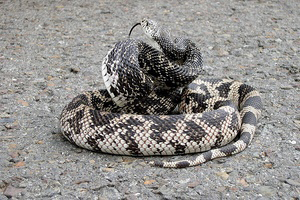Pinesnakes are not aggressive but can be impressively defensive when threatened. Defensive displays are loud hissing, inflating the body, vibrating the tail, raising the front part of the body, and striking (may be accompanied by a grunting sound).
Photo Credit: Zack Bittner
Pituophis melanoleucus
Common Name: pinesnake
Other Common Names: pine snake
Animal Guild: Reptile
Class > Order > Family: Reptilia > Squamata > Colubridae
What does the species look like?
Coloration varies greatly across the range. The northern pine snake (subspecies melanoleucus) is white to pinkish-cream with distinct black body blotches that become somewhat less distinct and brown toward the tail. The Florida pine snake (subspecies mugitus) is tan to gray-brown or rusty-brown with faded, indistinct, blotched pattern; the belly is pale and the darker dorsal blotches often cover the upper portions of the ventral scales. The black pine snake (subspecies lodingi) is nearly or totally uniform black or dark brown with a reddish snout and lip scales. Total length is up to 90 inches (229 cm), but most are much smaller. This species differs from other similar species by having the following combination of characteristics: scales with a ridge down the center (keeled), 4 prefrontals (scales just behind the rostral scale at the tip of the snout), and an undivided anal scale (scale that covers the vent). Rat snakes (Elaphe or Pantherophis) and kingsnakes (Lampropeltis), have only two prefrontal scales. Also, Elaphe/Pantherophis species have a divided anal scale. Whipsnakes (Masticophis), racers (Coluber), and indigo snakes (Drymarchon) have smooth body scales.
Where is the species found?
States & Provinces
AL, FL, GA, KY, LA, MD, MS, NC, NJ, SC, TN, VA, WV
Distribution
The range extends from extreme eastern Louisiana discontinuously east to eastern and southern Florida, and discontinuously north to Kentucky, Virginia, and southern New Jersey. Records for Arkansas, Maryland, New York, and Veracruz (Mexico) probably represent introductions.
Good quality pinesnake habitat appears to be characterized by xeric, pine-dominated or pine-oak (50 to 80% pine) woodland with an open, low understory established on sandy soils. Longleaf pine sandhills appear to represent critical habitat over much of the southeastern United States. Pinesnakes use forest openings, with level, well-drained sandy soils and little shrub cover, including early successional habitats in sites that have been previously disturbed by human activity, as nesting and hibernation sites. Pinesnakes may be active on the ground, underground, or in shrubs or trees. They remain underground or otherwise secluded in cold weather and during the hot midday period in summer. They may occupy mammal burrows (especially pocket gophers), gopher tortoise burrows, or dig their own burrow, aided by the enlarged scale on the tip of the pointed snout.
General Phenology and Life History
These snakes are most active in daytime but may be active at night or exhibit bimodal morning and evening activity in hot weather. The active season extends from about April through October in the northern part of the range. In the deep south, pinesnakes may be active during warm weather in winter. The mating period extends from April to early June over much of the range, perhaps extending into winter in Florida. Eggs are deposited in burrows excavated by the female in loose soil, under rocks or logs, or possibly in small mammal burrows. Eggs are laid primarily from late May to July. Clutch size is often 4-12 eggs, but may be larger in the largest females. Generally, individual females produce one clutch per year. Eggs hatch in about 7-11 weeks. Hatchlings emerge in August, September, or October.
Which phenophases should I observe?
Do you see/hear...?
Activity
Individuals on land More...
For abundance, enter the number of individual animals observed in this phenophase.
Feeding For abundance, enter the number of individual animals observed in this phenophase.
Development
Young individuals For abundance, enter the number of individual animals observed in this phenophase.
Dead individuals For abundance, enter the number of individual animals observed in this phenophase.
What do these phenophases look like?
There is currently no photoguide available for this species. If you'd like help us create one, use the guidance document and species template provided here . Then send it via email to education@usanpn.org when it is complete.
